Microwave synthesizer 4-7GHz
Microwave synthesizer - experiments with microwave black magic
Microwave synthesizer - experiments with microwave black magic
To make the experience fit your profile, pick a username and tell us what interests you.
We found and based on your interests.
|
Zip Archive - 29.35 MB - 06/29/2021 at 16:34 |
|
|
|
Zip Archive - 36.93 MB - 03/29/2020 at 12:41 |
|
|
|
Open Web Media Project - Video - 8.17 MB - 03/29/2020 at 12:01 |
|
Most of measurements are done using librevna. It has harmonic mixing mode which allows to make some measurements above 6GHz (although be careful with measurements of active devices and fundamental frequency is still there). Calibration was done using PCB test fixtures as shown below (SOLT or TRL possible).
One of the VCOs was tested – 3-3.5GHz. Output level was tested with LibreVNA, previously calibrated using good RF generator. The level is near to 0dBm in the whole frequency range. The results look ugly because 1. LibreVNA is not spectrum analyzer and shows the unwanted tones, 2. no shielding, 3. no closed loop PLL, just VCO alone so the low frequency noise is not filtered by PLL.
Example measurement:
VCO 3-3.5GHz, at 3GHz, 50R added in series, measured value with added
10dB attenuator - power -1.5dBm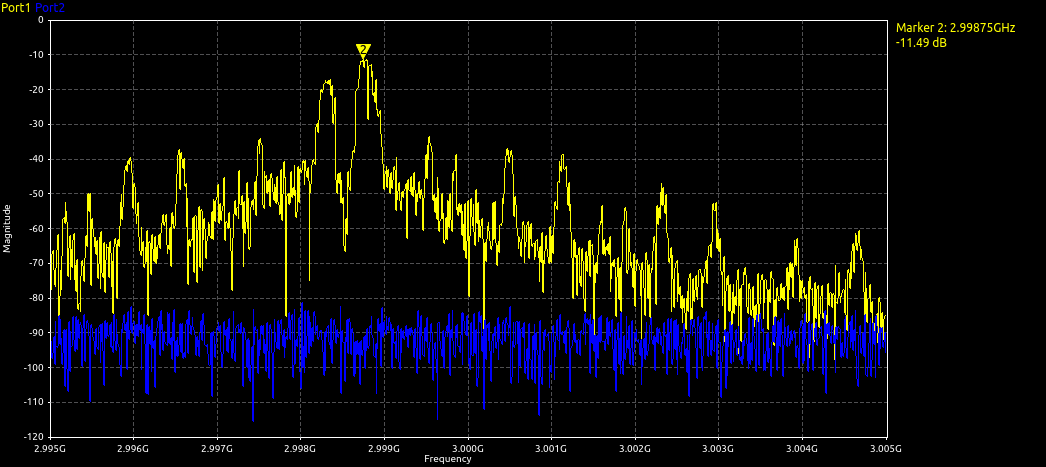
Not tested but expected to be not worse than filters switch
Typical application of BAP64Q 4-diode attenuator – 2.7dB insertion loss, 23dB attenuation at 3.5GHz.
Initially there was
a weird shape of gain characteristic.
It’s hard to test because I’ve no proper equipment for the task. I tried testing is in connection with amplifier to drive it with reasonable level and output filter to have only one tone – then the signal is measured with a HP 33330B detector. Power of the signal with amplifier is compared with power of the signal after doubler and filter.
Loss of the doubler is probably about 10dB (13-16dB including with filter)
Also I did simulation in spice which confirms about 10dB loss and confirms that doubling works best with not too high input power, less than 10dBm.
Filters were measured and the results were ok, loss better than 5dB on FR4, only center frequencies should be slightly increased.
Only one diode
tested. The switch was redesigned. Two PIN diodes in series provides
better attenuation when off and have not bad insertion loss when on.
Larger pieces of copper between the diodes are to partially
compensate diodes inductances by adding some capacitance (works in simulation, not sure if also
in real world).
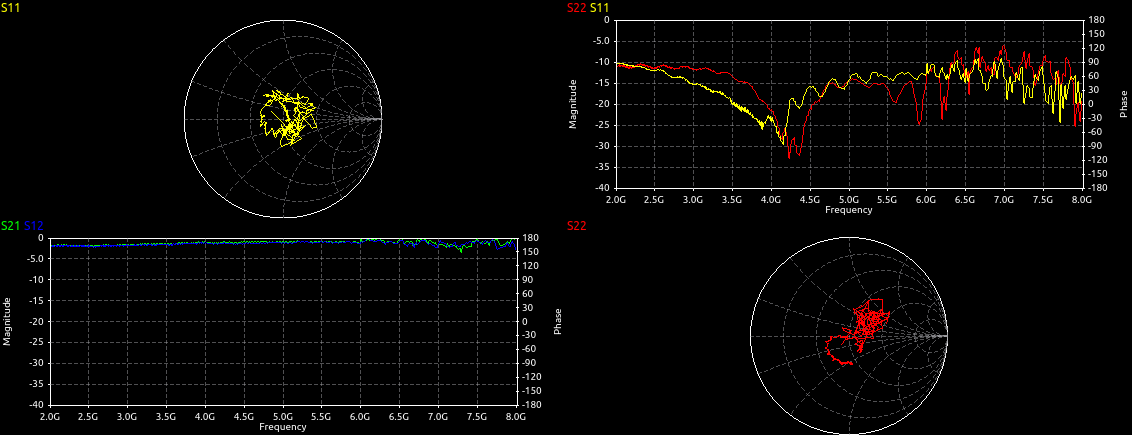
New amplifier was designed, measured and tuned.
Gain of 3 amplifiers connected (note: 2x 10dB attenuator installed – real gain is 22-27dB).
Low pass output filter was removed because it probably didn’t work well (acc. my inaccurate measurements, too much loss at 7GHz and poor attenuation above).
Improvements of PLL filter was important for phase noise. Initially, with both PLLs performing poorly I couldn’t get any results with RBW set to 1kHz.
Dedicated software was used for the design, together with testing, trails errors.
With both filters for both PLLs (1st and 2nd LO) RBW 1kHz makes more sense. The filter removes a low of low frequency noise (which is large, especially in the prototype without any shielding)
I've made a new revision of the project. See LO1rev2_design_pack.zip for KiCad design, various simulations, design description. It's mostly redesigned, a little simplified although still I didn't try to avoid silly design decisions so don't expect high performance or usefulness of the design.
Short summary of changes:
Unfortunately I've not much possibilities of measurements above 6GHz (up to 6GHz I use arinst-ssa, although it has undefined performance above 3GHz), also measurements in the circuit (without cutting out a measured block or making a new copy) are inaccurate (SWR of connections matters a lot) so I'm highly uncertain about performance of particular circuits. The whole synthesizer provides about 7dBm max over the 4-7GHz range, if I can trust a 20$ power meter (I can't actually...).
I closed the level-control loop and the PLL. After a few more small changes it works.
I skipped the second part of output amplifier (was unstable) and the first part seems to work good enough. I also skipped amplifiers after VCOs and added attenuator after 2-2.5GHz pin attenuator (too much gain). Variable attenuators were too sensitive to tuning voltage (at certain frequency and tuning voltage) so I introduced some imbalance as workaround. Other changes are listed in changes_rev1 text file in the project zip.
Recently I had chance to access a good spectrum analyzer for a while so I checked the results. The output signal looks bad (spurs, jitter), partially (mostly?) because I didn't even shield anything. Also I'm not 100% sure if everything is stable and not overdriven. The main tone is about 12dBm, it drops to about 8dBm close to 7GHz but in the remaining part of frequency range the output level is surprisingly flat (maybe about 2dB flatness below 6.7GHz). See the video in "files" (note 10dB attenuator was installed).
1. VCOs - they work (after some tuning, and replacing one transistor)
2. Amplifiers (2-3.5GHz in three ranges) - they are ok, VCOs output signal is higher than expected so maybe I need one instead of two amplifiers or I must add some attenuators
3. Atternuators - they work, attenuation range about 10dB (not much but close enough to simulations)
4. Doublers - they work (2nd harmonic much above the input), no accurate measurements done yet
5. PIN switch - it does something but I can't test it separately with the current PCB layout (maybe I'll attempt it later)
6. Filters - the lowest band looks fine, it's hard to test the others (measurements errors can be bad at so high frequency and currently I can't go above 6GHz)
7. Output amplifier first part (3 stage) - not good, hard to test, seems to be unstable but possibly the problem is caused by test setup (depending of arrangement of coax cables connected to PCB it oscillates or not); possibly it can be useable after some tuning
8. Output amplifier the second part (2 way) - part1+part2 output amplifier is much more unstable than the first part only so I'll skip the two-way amplifier for now; it's bad because of huge out of band gain, especially about 2GHz where it usually oscillates.
So the plan for now is to put all together, without the final amplifier.
The PCB has arrived, now the prototype is mostly assembled.
The fist impressions:
- I checked one VCO and seems that it works surprisingly well
- I also checked one 3-3.5GHz amplifier - it's fine
- The wideband 4-7GHz seems to be fail. First of all it's unstable. Also it's quite difficult to make any meaningful measurements, even with a good VNA (I had chance to use it for a few days) - U.FL connectors are quite bad even at their specified 6GHz and currently I can't test the two stages of the amplifier separately because I don't have connector between them. The problems are likely caused by radial stubs which may couple to each other and also diverge from simulation.
I hope to make more measurements soon.
The main challenge will be to fix the 4-7GHz amplifier (at least up to 4-6GHz where I can currently measure it). The worst case will be to replace it with integrated gain blocks but they are noisy, expensive and boring.
There was problem with the attachment but now you should be able to download it.
If you want to open PCB you need the newest/unstable kicad (I'm beta tester).
I also added photo with my experimental circuits (chalk overlay paper technology).
The design of the first version is finished and I'm waiting for PCBs.
I expect that not all the circuits will work as intended and most of them will require some tuning. On the other hand I'm pretty sure I'll be able to make them to work because I did a lot of simulations and also some experiments. I tested some of the used (or similar) circuits, mostly using cheap Arinst SSA-TG spectrum analyzer (up to ~6GHz) and it looks like the simulations really help to roughly estimate how the real world hardware will work. Not all the parts were tested so problems may arise, especially at the highest frequencies.
To be continued...
Design and reports are attached (as zip file) in "Files" section.
Create an account to leave a comment. Already have an account? Log In.
Thanks for the suggestions.
The ALC is because I expected that all the parts of the signal path will have extremely poor bandwidth flatness ;) Maybe this could change in next versions (I'm preparing rev2.1 but I don't expect it to be the final one). I finally bought LibreVNA which is great help with tuning the circuits even up to 7GHz so I can see possibilities to improve the bandwidth flatness. In rev2 the biggest problem was very bad output amplifier (for some reason I wasn't able to get any agreement between simulation and reality, while nearly identical 2-3.5GHz amplifier was suprisingly good).
I didn't test the temperature dependency of the detector yet, only did some simulations in qucs, it seems to be doing something (asdf_sa_LO1_test_2020-03-29_a.zip\LO1\design\detector_doc.odt).
I didn't test shielding yet (I'm thinking about conductive plastic 3D print), when I'll get to the point I'll consider checking if separating doubler from amplifier will help.
I've got a question about the "cavity resonances" - what problems can they cause? Are the problems easy to create in real world? How hard to fix?
Black magic indeed - your board ended up with three kidneys!
Be sure to stop by today's Hack Chat of you can - Weird World of Microwaves with Shahriar from The Signal Path: https://hackaday.io/event/167683-weird-world-of-microwaves-hack-chat
Should be right up your alley.
Become a member to follow this project and never miss any updates
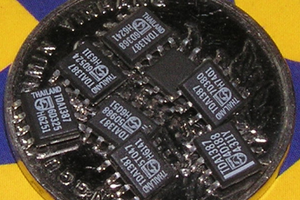
 Richard Dudley
Richard Dudley
 kevarek
kevarek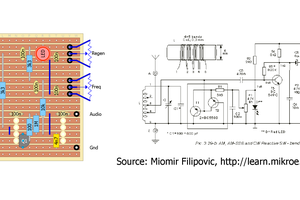
 agp.cooper
agp.cooper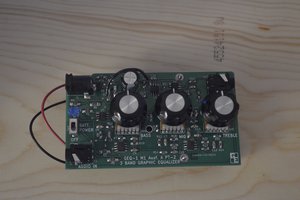
 Grant Giesbrecht
Grant Giesbrecht
Kudos to you for designing the VCO's and amplifiers from discrete transistors!
Why did you decide to use ALC power control in the LO for driving the mixers in the spectrum analyzer? It would be simpler to use 50 ohm gain blocks that are driven a few dB into compression to flatten out power level variations over the LO frequency range. Adding some gain equalizers would also help flatten the power variation. The LO drive to the mixer doesn't require the level of accuracy that an ALC would provide.
I noticed the dual diodes in the ALC level detect circuit. It looks like one diode is used to track the temperature drift of the main one and the differential amp subtracts out the temperature drift. How well does it work?
Assuming that your board is going to be covered with a shield, the cavities for the doubler and the circuit before it (a quadrature hybrid?) are very large. Cavity resonances causing spurs would be a concern.